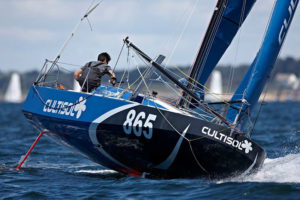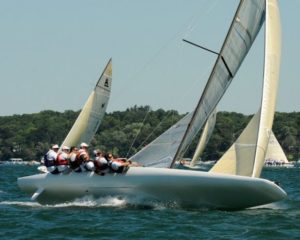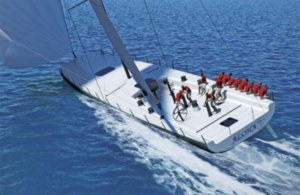The Mini Transat fleet is certainly the breeding ground for major offshore sailboat racing innovation. While closely regulated (especially for all safety matters), there’s still plenty of leeway for Mini development. And one is not likely to find a more resourceful and creative sailing fraternity than Mini sailors. Anything happening in that class is worth keeping track of.
This past week’s 700-mile Mini Fastnet Race was won handily by proto class 754 EPC Reves de Clown, the original scow-bow. In the middle of the proto fleet was the new scow-bowed 864, dubbed Maximum for the event and skipper by Davy Beaudart. Apparently slowed by some damage to that magnificent blunt bow, the boat has already shown signs of superior speed. And 754 remains virtually unbeatable.
There’s nothing new about scow bows. Scows have had them for years. . . Anyone who questions their effectiveness just needs to watch an A or E-Scow. But the fact that they’ll get pounded by the waves upwind, which they will, appears to be offset by the high prismatic coefficient (full ends) that adds up to higher off-the-wind speeds.
While designers are never particularly forthcoming with their ideas for innovation, at least one 90-footer currently in the works has a scow bow. Being designed by Reichel Pugh, the boat is aimed at fast Transpac Races in the years to come.
While it’s clear that racing boat designers are going to be developing the scow bow approach to some extent or another, it will be interesting to see if the trend ends up in the production boat world as well. There’s no end to the demand for useable space on cruising boats, so if scow bows become an accepted aesthetic, we all may be sleeping in a box berth instead of a V-berth forward one of these days.
I’d be just fine with a blunt-nosed offshore cruiser. Just another reason to plan downwind passages.
Thoughts?


